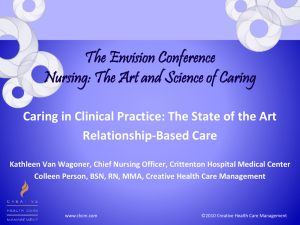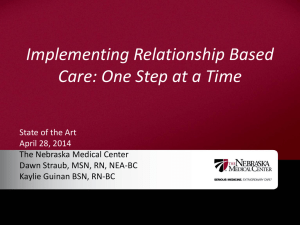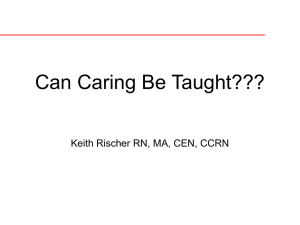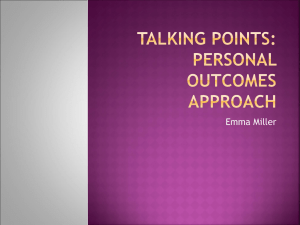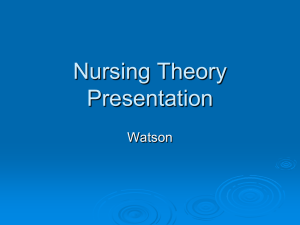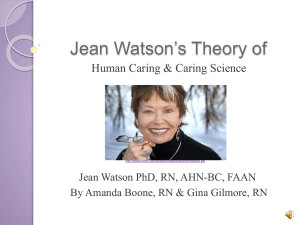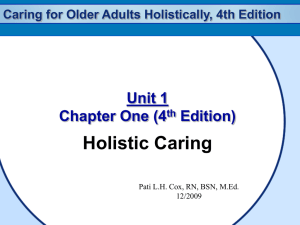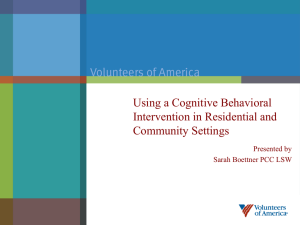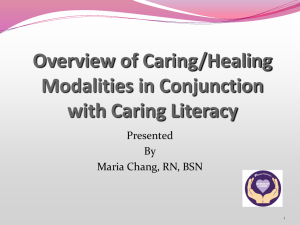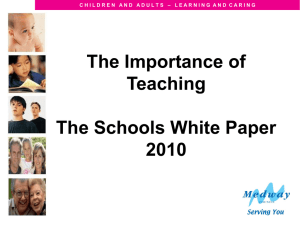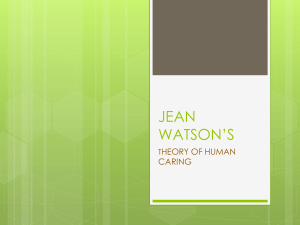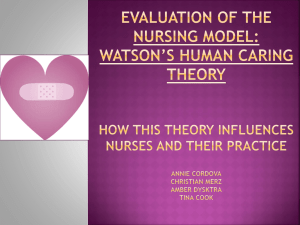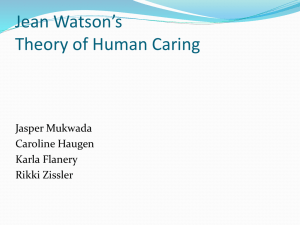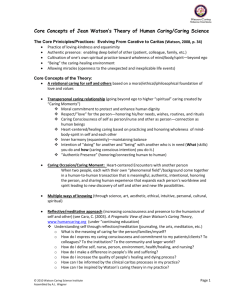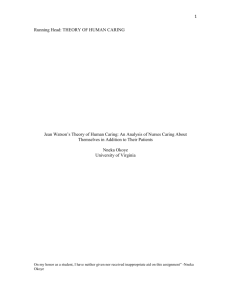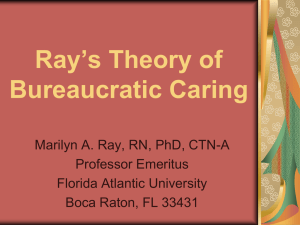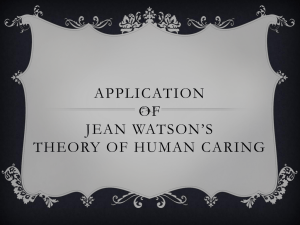It is a beautiful and mysterious power that one human being can
advertisement
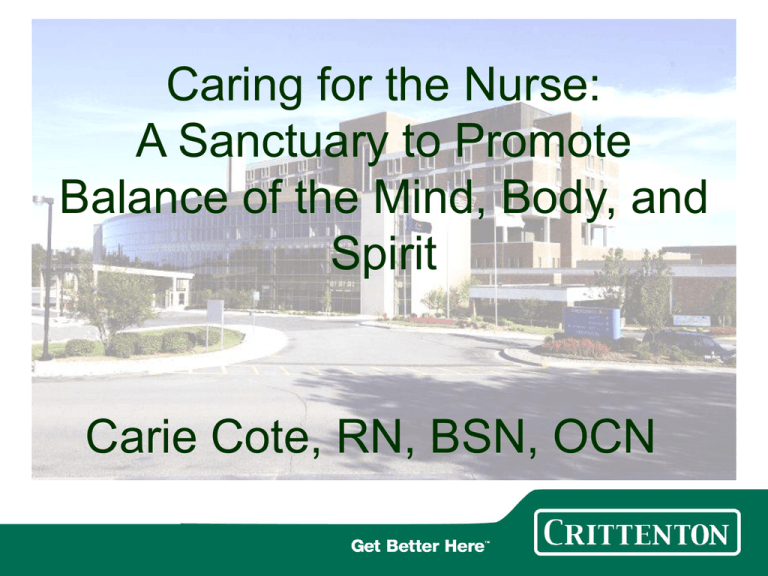
Caring for the Nurse: A Sanctuary to Promote Balance of the Mind, Body, and Spirit Carie Cote, RN, BSN, OCN It is a beautiful and mysterious power that one human being can have on another through the mere act of caring…A great truth, the act of caring is the first step in the power to heal -Phillip Moffitt Gratitude unlocks the fullness of life. It turns what we have into enough, and more. It turns denial into acceptance, chaos into order, confusion into clarity.... It turns problems into gifts, failures into success, the unexpected into perfect timing, and mistakes into important events. Gratitude makes sense of our past, brings peace for today and creates a vision for tomorrow. -Melodie Beattie Happiness cannot be traveled to, owned, earned, worn, or consumed. Happiness is the spiritual experiences of living every minute with love, grace, gratitude -Denis Waitley Lead with Purpose We experience the essence of care in the moment When one human being connects to another - Mary Kolorutis To work in the world lovingly means that we are defining what we are for, rather than reacting to what we are against -Christina Baldwin Relationship-Based Care Journey Towards Self Discovery Mind Body Spirit Unit Practice Council • The Unit Practice Council was developed to implement the Elements and Principles of Relationship-Based Care (RBC) into practice. • The Unit Practice Council is comprised of nurses, nursing assistants and unit secretaries. • Work in a collaborative effort with all members of healthcare team to create a more caring and healing environment. Relationship-Based Care Model the Way Begin Where You Are Learn by Doing & Reflection Inspire a Shared Vision Transformational Leadership Cycle Go with the Energy Create Awareness Model the Way www.chcm.com Lead with Purpose (Koloroutis, 1998) Our Journey • 6 East Unit Practice Council • RBC Element #1: Caring and Healing Practice Environment 1. What would it take to re-create the physical environment to achieve a more caring and healing setting? 2. What do we need to do to support self care and healthy colleague relationships on our unit? Literature Review • Nurses are challenged to perform more tasks with fewer resources leading to decreased job satisfaction and higher turn over rates (Christmas, 2008). • Self awareness leads to intentional caring, caring with thought and purpose (Koloroutis, 2004). • Developing a culture of shared knowledge and values may serve as a guide to heartfelt caring practices that are grounded in both theory and evidence (Watson, 2006). Professional Impact on Patient Outcomes Kinnaird & Dingman (2004) postulated that caring interactions between the nursing staff and the patients may improve mortality rates, decrease length of stay, reduce the number of adverse incidents, decrease the number of complications, increase patient and family satisfaction with nursing care, and overall improve adherence to discharge planning. Development of Our Sanctuary • Unit Practice Council Members determined elements of self-care practices to include in Our Sanctuary • • • • • • • Meditation Lighting Guided Imagery Aromatherapy Sound Colors Reflective journaling Reflective Journaling • “I honor this space and sanctuary-may it be the place of respite we all need -today and in the future” • “The little acts of kindness that are performed here every day inspire me to do better-work harder-love deeper-care always” • “Thank you for this 5 minutes-I feel refreshed and relaxed!” • “My hopes and aspirations for this room are that we use it each and every day to put a little pieces back for the parts we give of ourselves so selflessly” •“I feel blessed to have such an amazing space for our caregivers. I am excited about the possibilities this will bring for us, our energy and out intentions” •“I am grateful for this space to come and re-center so that I can be I intentional and purposeful with my interactions” •“I am grateful for this room to come and relax and clear my mind. I am not having a bad day, I just wanted to regroup and make sure it would stay that way” Sanctuary An ever open door Peace within Dwelling there Like a living thing A place to kneel and pray Where the soul can soar Heavenwards Like a bird on the wing Refuge and rest A quiet happiness Contentment and love Beyond compare A haven in the world of care ~Elizabeth Anderson Survey Results Thus Far • 93% (n=17) of our nursing staff have reported that they “Strongly agreed” that the time they have spent in Our Sanctuary was beneficial to “your ability to care for your patients with a more intentional, healing presence”. • 6% of our nursing staff have reported that they “Somewhat” felt the time they have spent in Our Sanctuary was beneficial to “your ability to care for your patients with a more intentional, healing presence”. • “Just taking a moment out of the busy day has re-centered myself, renewed my energy to complete/finish out the day-Thank you” • “The music had a very calming effect on me” • “A perfect place-helps to relax, calm, reflect, even if you are having a good day!” • “Spending a few minutes in this room reminds you of why you do this job- for all of the challenges we face, it reminds you of all of the good there is” • “This is a good way to re-group, I feel fortunate to have this room” • “The recliner is awesome! It is very comfy- It is nice to get away, especially since there is no place to go on night shift” What inspires you? References • Christmas, K. (2008). How work environment impacts retention. Nursing Economics, 26(5), 316-318. • Kinnaird, L. & Dingman, S. (2004). Outcomes measurements. In M. Koloroutis (Ed.), Relationship-based care: A model for transforming practice (pp. 215-248). Minneapolis, MN: Creative Healthcare Management. • Koloroutis, M. (2004). Introduction. In M. Koloroutis (Ed.), Relationship-based care: a model for transforming practice (pp. 1-22). Minneapolis, MN:Creative Healthcare Management. • Swanson, K. (1991). Empirical development of a middle range theory of caring. NursingResearch, 40(3), 161-166. • Swanson, K. Five Caring Processes – Interview. http://www.chcm.com/docs/caring_made_visible.pdf • Watson, Jean. Watson Caring Science Institute International Caita Consortium. Retrieved from http://www.watsoncaringscience.org. • Watson, J. (2006). Caring theory as an ethical guide to administrative and clinical practices. JONA’s Healthcare Law, Ethics, and Regulation, 8(3), 87-93. • Watson, J. (2008). Nursing: the philosophy and science of caring. Boulder, Co: University Press of Colorado.

